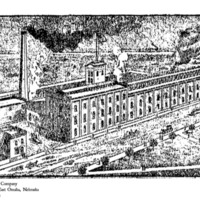Carter White Lead Company
Dublin Core
Title
Carter White Lead Company
Subject
Omaha Industrial Lead
Description
This artifact image shows a colorless dotted drawing of the once existent Carter White Lead company plant, which manufactured household paint. This image in particular shows the plant that was once located in the Eastern region of Omaha in the factory district, which was open from 1878 to 1936. In the image, you can see a big building with many chimney shafts. There seems to be lots of thick and heavy smoke venting out of the chimneys into the surrounding atmosphere. This was a main form of its contribution to lead exposure outside of its product use. Much of the smoke contained small lead particles dues to the industrial processes and settled into the dirt throughout the surrounding area of Omaha (Sasse, 2016). Workers were exposed to this air much more closely than most. According to the EPA, much of these settled lead particles eventually sunk down into the watersheds groundwater system (EPA, 2016). You can see the building had many windows to allow ample light to the workers. On the outside, you can see what appear to be many people walking around the building and horse drawn carriages traveling by the building. On the bottom left of the image, both the name of the company and the address of the plant are written.
Between 1910 and 1920 when the Carter White Lead was still in operation, lead use continued in its expansion with very little resistance. One of the main reasons for this expansion was due in part to world war one. During the war, many of the supplies needed for the war effort required lead based products. For example, the increased demand for ammunition produced allowed companies such as Lawrence Shot and Lead Company to make more sales, leading to increases in production quantities (USGS, n.d.). Another example is leaded paint, which was required for the planes, vehicles, and other military equipment (USGS, n.d.). US forces also depended upon canned food. The cans were smoldered with lead alloy. There were also many more examples, such as bearing metals, cable covering, caulking lead, batteries, as radiation shielding in medical analysis, and more (USGS, n.d.). Thus businesses evidently increased in profits rapidly while exposing more people to their lead contaminated.
Businesses such as Carter White Lead, the Lawrence Shot and Lead Company, and many others increased production and profits, but as a consequence, evidently exposed more people to their lead hazards. This is a prime example of how the industrial lead industry gained profits off of injustice. Especially during a time where most people were focused on the war, exposure to lead may not have been an area of focus for many of the people who were exposed and impacted.
CITATIONS-
Adam F. Sasse. (2016, April 18). A History of Lead Poisoning in North Omaha. Retrieved from https://northomahahistory.com/2016/04/18/a-history-of-lead-poisoning-in-north-omaha/.
Lead in Outdoor Air. (2016, November 28). Retrieved from https://www.epa.gov/lead/lead-outdoor-air.
National Minerals Information Center. (n.d.). Retrieved from https://www.usgs.gov/centers/nmic/lead-statistics-and-information.
Between 1910 and 1920 when the Carter White Lead was still in operation, lead use continued in its expansion with very little resistance. One of the main reasons for this expansion was due in part to world war one. During the war, many of the supplies needed for the war effort required lead based products. For example, the increased demand for ammunition produced allowed companies such as Lawrence Shot and Lead Company to make more sales, leading to increases in production quantities (USGS, n.d.). Another example is leaded paint, which was required for the planes, vehicles, and other military equipment (USGS, n.d.). US forces also depended upon canned food. The cans were smoldered with lead alloy. There were also many more examples, such as bearing metals, cable covering, caulking lead, batteries, as radiation shielding in medical analysis, and more (USGS, n.d.). Thus businesses evidently increased in profits rapidly while exposing more people to their lead contaminated.
Businesses such as Carter White Lead, the Lawrence Shot and Lead Company, and many others increased production and profits, but as a consequence, evidently exposed more people to their lead hazards. This is a prime example of how the industrial lead industry gained profits off of injustice. Especially during a time where most people were focused on the war, exposure to lead may not have been an area of focus for many of the people who were exposed and impacted.
CITATIONS-
Adam F. Sasse. (2016, April 18). A History of Lead Poisoning in North Omaha. Retrieved from https://northomahahistory.com/2016/04/18/a-history-of-lead-poisoning-in-north-omaha/.
Lead in Outdoor Air. (2016, November 28). Retrieved from https://www.epa.gov/lead/lead-outdoor-air.
National Minerals Information Center. (n.d.). Retrieved from https://www.usgs.gov/centers/nmic/lead-statistics-and-information.
Creator
Rohit Akella,
Betty Straub
Betty Straub
Source
NorthOmahaHistory.com
Publisher
Adam Fletcher Sasse
Format
https://northomahahistory.com/2016/04/18/a-history-of-lead-poisoning-in-north-omaha/
Language
English
Collection
Citation
Rohit Akella,
Betty Straub, “Carter White Lead Company,” History of Environmental Inequalities, accessed May 2, 2024, https://steppingintothemap.com/inequalities/items/show/36.
Embed
Copy the code below into your web page
